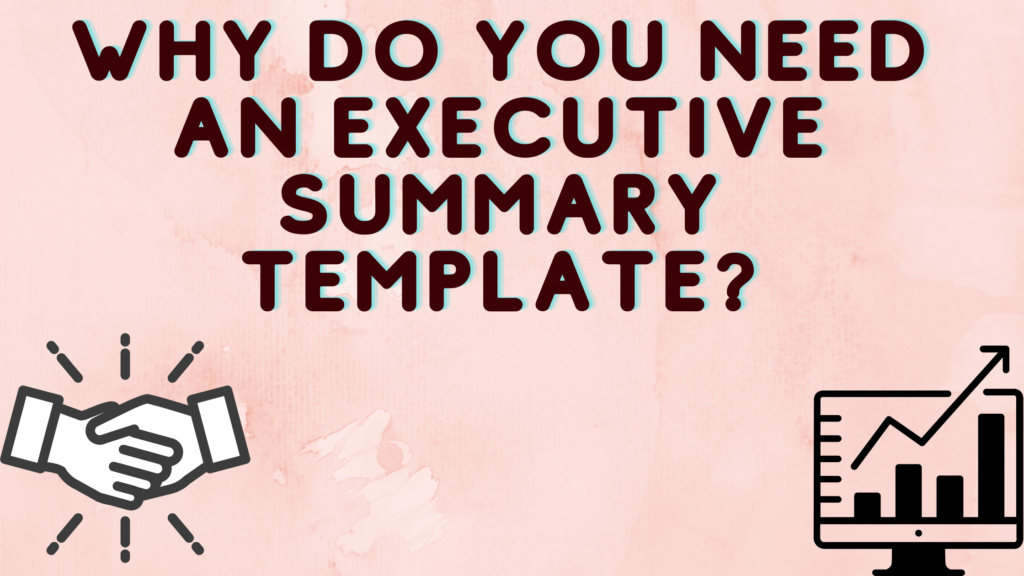
Before going into the details of your business plan or project proposal, the first step should be an executive summary that will grab the attention of those with the ability to make a case. AN executive summary template will be immensely helpful.
Think of the abstract as the back cover of a book. Convince readers to buy a copy because the plot is worth their time. Investors and C-level managers with limited time are rarely motivated to read the entire business or product plan without a compelling summary. This article will also give a format for your executive summary.
What is an executive summary for a business plan?
Abstracts are short summaries of more significant documents, such as a Business plan. Briefly outline your business plan with details such as company description, financial information, and market analysis. This is the purpose of the executive summary.
This summary is intended for lenders, investors, and busy business owners who don’t have time to read the full article. Done right, it focuses on what potential investors and project sponsors want to hear and communicates business value. Many investors will be inclined to read the Executive Summary upon first contact with your company, so it should contain all the necessary information. An executive summary example will be explain
What must be the goals of your summary template?
- Grab the reader’s attention
- Communicate what to expect from your business plan and stay motivated to read on
- Get an overview of your business, short-term and long-term goals
- Acts as an elevator pitch. An abstract summarizes a document like a journal article, and an executive summary summarizes a longer paper.
- Read your executive summary twice to see if it makes sense.
Difference between executive summary, abstract and introduction
In science, abstracts are a prerequisite for conference paper submissions, book proposals, or research grant applications. Abstracts are independent original documents, not excerpts. The executive summary is intended for the business audience. It contains information to assist management in making funding decisions. If the abstract language is technical, the summary language is non-technical. It is written as a condensed version of the project plan to ensure approval, but the abstract is written for guidance. An effective executive summary must be concise and give a quick overview of the business or project.
The introduction is the first part of a project plan or business plan. Describe what your project is and what you want to achieve. On the other hand, a summary is an independent document compressed into several paragraphs. High degree of perfection and high level. A decision maker can get the gist of the entire project proposal by reading just the executive summary.
Think of this introduction as the first few pages of a lengthy book with many chapters and the executive summary as a short one-chapter book. You can understand the context and plot by reading short texts. You can use this executive summary to pitch your idea to investors.
Elements of an Executive summary template
Learn what to include in an executive summary here. Writing your executive summary requires a lot of thought.
- Introduction
In the case of a business plan, the introduction is the opening statement that explains the document’s purpose. Your goal is to capture and retain your reader’s attention by clearly communicating your company’s values and desired outcomes.
2. Description of the company
Include the following information in your company description: Company name and location
- contact address
- project objectives
- Your company’s leadership, founders, and current investors
- the team responsible for the project
3. Products and services offered by your company
Briefly describe the problem you are trying to solve. If you have conducted research that indicates the need for a proposal, please submit your findings here. Also, explain how you will achieve your project goals and what you need for success.
4. Analysis of the market
This section should answer a few questions.
- Is there a market opportunity that you can exploit for the problem?
- How do you plan to expand your customer base and increase your market share?
- What is your 5-year growth plan for this product/service?
- What’s the most exciting thing that you learned about your target audience that your readers should know?
5. Conduct a competitive analysis for your product or service
Questions to answer as part of your competitive analysis include:
- Who are your competitors?
- What are the current and future possibilities?
- What is your unique value proposition of the product or service that you are offering?
- Do you have experience with your competitors?
- What are the specific risks for this niche or product line?
- What obstacles do you hope to remove?
6. Funding details
Use this section to sweeten your investor’s pot. How much business capital do you need? How profitable is your company? How Do Investors Profit?
7. Show financial projections
Add financial data to support your investigation, such as:
- Business plan budget base
- Projected sales for the first three years
- A plan for managing finances
- current and future business finances
8. Conclusion
A conclusion is a summary of the problem and solution. Ask your readers about the decisions you want them to make. The result should be obvious but leave room for intrigue that makes you feel compelled to read the rest of your business proposal. Read the proposal once before finalising the terms. Add impact to your report at the end
Tips to write an executive summary well
- Logically organize summaries. The most essential and salient elements should be placed at the top of the document. Once you’ve finished writing, edit and proofread your summary before sending it to anyone. We encourage you to ask a colleague or mentor for a review.
- Use clear and concise language, free of jargon and buzzwords. If you’re writing for a specific audience, it’s essential to write in a way everyone can understand. Again, research is done here. If the brands you’re targeting all use the same vocabulary, be Sure to use that language in your abstract. This sends a signal to brands that they understand their industry and market. However, they may not always know the jargon you use as an influencer or creator.
- Different readers use different tones when writing summaries. This requires research on the brands they offer. Consider using more technical language if you’re writing for a more conservative, down-to-earth corporate brand. Using a more whimsical and fun brand makes the summary lighter. Please be sure to use personal pronouns such as “I”, “we” and “our” instead of references such as “company” or “customer” as this is not a terms and conditions page .
- You should always let people know what the next step should be. Otherwise, they do nothing. At the end of the summary, tell the reader what to do next. It should be as simple as, “When you’re ready to drive traffic and increase sales with influencer marketing, let’s talk!” and include your contact information. It’s time to sell yourself. Let your readers know you know what you’re doing. This section includes social proof, hard results, and stats showing how past partners have benefited from your work.
- Clearly define the problem you can solve for the brand you are promoting. What is the business need behind the product or service that you’re offering? What are they missing out by not working with you? I am here to let my readers know that I understand their pain and that I can offer a solution.
Use the Executive Summary Template in this link.
